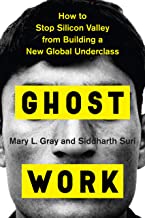There’s some very interesting insight into the human workforce making the digital platforms work in Ghost Work: How to Stop Silicon Valley from Building a New Global Underclass by Mary Gray and Siddarth Suri. The book as a whole doesn’t quite cohere, though, nor deliver on the promise of the subtitle. The bulk of the book draws on interviews and surveys of people who work via platforms like Amazon’s famous Mechanical Turk, but also the internal Microsoft equivalent, UHRS, and a smaller social enterprise version, Amara.
This is all extremely interesting, about how people work – in the US and Bangalore – their tactics for making money, dealing with stress, how many hours they have to work and when, how much or little agency they have, and so on. Not least, it reminds or informs readers that a lot of AI is based on the labelling done by humans to create training data sets. However, not all the ghost work described is of this kind and some, indeed, has little to do with Silicon Valley except that a digital platform mediates the employer and the seeker of work. As the authors note, this latter type is a continuation of the history of automation, the role of new pools of cheap labour in industrial capitalism, and the division of labour markets into privileged insiders and contingent – badly paid, insecure – outsiders. The new global underclass is just one step up from the old global underclass; at least they have a smartphone or computer and internet access. The survey results confirm that some of the digital ghost workers value the flexibility they get reasonably highly – although with quite a high variance in the distribution. Not surprisingly, those with least pressing need for income most value the flexibility. Some of the women workers in India also valued the connection to the labour market when they were unable to work outside of their home because of childcare or family expectations. Similarly, with the Amara platform, “Workers can make ghost work a navigable path out of challenging circumstances, meeting a basic need for autonomy and independence that is necessary for pursuing other interests, bigger than money.”
The survey results confirm that some of the digital ghost workers value the flexibility they get reasonably highly – although with quite a high variance in the distribution. Not surprisingly, those with least pressing need for income most value the flexibility. Some of the women workers in India also valued the connection to the labour market when they were unable to work outside of their home because of childcare or family expectations. Similarly, with the Amara platform, “Workers can make ghost work a navigable path out of challenging circumstances, meeting a basic need for autonomy and independence that is necessary for pursuing other interests, bigger than money.”
The book’s recommendations boil down to recommending that platforms should introduce double bottom line accounting – in other words, find a social conscience alongside their desire for profit. Without a discussion of their (lack of) incentives to do so, this is a bit thin. Still, the book is well worth reading for fascinating anthropological insights from the field work, and for the reminder about the humans in the machine.
